

Spatial Treatment in Childrens Drawings. How Constraints Force Your Brain To Be More Creative. When Sarah Stoesz became the CEO of Planned Parenthood Minnesota, North Dakota, South Dakota 15 years ago, her affiliate included 29 clinics.
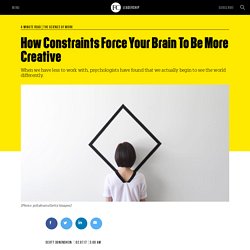
Today, there are 19. A barrage of state laws restricting abortion access, funding cuts, and anti-choice policies have caused clinic after clinic to close, leaving large swaths of the region without access to quality reproductive health care. 7 Women Artists Who Changed History - Multicultural Kid Blogs. By March is Women’s History Month.
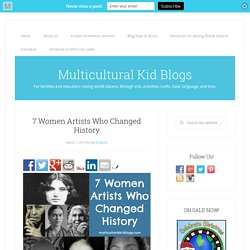
Here at Multicultural Kid Blogs, we’ll be celebrating all month with fantastic posts from contributors all over the world. To start off the series, let’s learn about seven influential women artists. Topics for your Art projects – Mr. Mitchell's Online Studio Art Classroom. Show Us Your #SinglePointRubric. The practice of using single point rubrics is slowly but surely catching on.
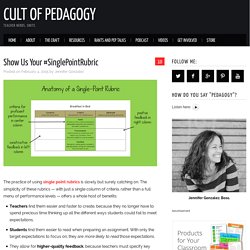
The simplicity of these rubrics — with just a single column of criteria, rather than a full menu of performance levels — offers a whole host of benefits: Teachers find them easier and faster to create, because they no longer have to spend precious time thinking up all the different ways students could fail to meet expectations.Students find them easier to read when preparing an assignment. With only the target expectations to focus on, they are more likely to read those expectations.They allow for higher-quality feedback, because teachers must specify key problem areas and notable areas of excellence for that particular student, rather than choosing from a list of generic descriptions.
Show Us Your #SinglePointRubric. How i build a choice based lesson - Art Ed Guru. Balance: Choice-Based Learning and the National Arts Standards. After posting about my 'Careers in Art' series recently (click here).
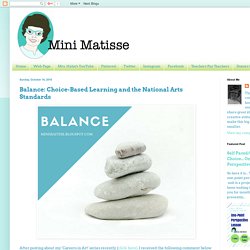
I received the following comment below from Kellie Determan. It sounds like Kellie is exactly in the same place I found myself about two years ago. Two years ago I started watching the posts from TAB teachers and loving the concept of an Art Studio versus an Art Class. I would offer a little choice in my class and post it to the TAB groups on Facebook. Four Reasons I’m Thankful to Teach Art - The Art of Ed.
I didn’t always want to be a teacher, though art has always been a huge part of my life.
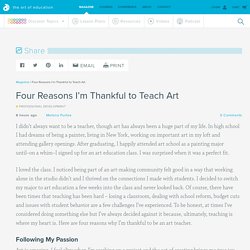
In high school I had dreams of being a painter, living in New York, working on important art in my loft and attending gallery openings. After graduating, I happily attended art school as a painting major until–on a whim–I signed up for an art education class. I was surprised when it was a perfect fit. I loved the class. I noticed being part of an art-making community felt good in a way that working alone in the studio didn’t and I thrived on the connections I made with students. How to Help students understand the Drawing Issues. Usually when when students hear the words, ” drawing issues,” they look confused and unsure, then they realize that the drawing issues are made up of terms that they’ve heard for years, but often still aren’t sure how to use them in their artwork.

Below if the video that I use as an introduction to drawing issues. Grab the slides here This is perfect if you've been teaching AP for years or if you're just starting out. This bundle includes my go to tools that I use over and over again when teaching AP Art. Here's what's included:- AP Drawing Concentration Tracking( designed to help keep your students focused and responsible for their work, this chart helps them to keep track of what they've done, and what they still need to do)
HELP! HOW CAN I GET MY STUDENTS TO PRODUCE QUALITY ARTWORK? The truth is, you won't.
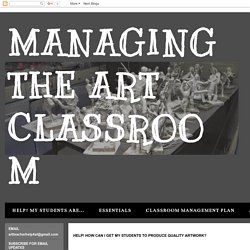
At least, you won't be able to get everyone to produce "quality" work. They are children, after all! Teacher Engages Class With Incredible Drawings Every Day – Bored Teachers. An art teacher at Paola High School in Kansas goes above and beyond for her students on a daily basis.

Mrs. DeAnna Morgan has the artistic talent of drawing on a whiteboard that most teachers can only dream of having. She creates masterpieces on the board EVERY DAY before class, to connect with her students and give them something to enjoy when they walk into her classroom. 7 Strategies to Help You Survive Your Largest Class - The Art of Ed. Large classes pose special challenges in the art room.

When you see a class list that includes 30, 35, or even 40 kids, your mind starts racing. Do I have enough scissors? How will forty kindergartners ever wash their hands in a timely manner? How on earth will I store all these projects? I’m here to tell you, I’ve been there–sometimes with 42 kindergartners at once. Managing All that Artwork!: folder, class art and art show organization - Art Teacher Smile.
I’m at the elementary level, which means throughout the day I’ll see a mix of Pre-K-fourth grade, usually six classes a day.
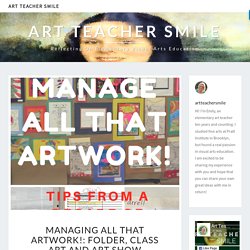
Our classes change every forty minutes with five minutes passing time in between (typically, but not always.) Keeping ahead of the game through good organization is how I manage the insanity. Here are some of the processes I’ve developed over the years to aide in that organization. If You Want Your Children to Survive the Future, Send Them to Art School. Can you imagine a world in which most jobs are obsolete? If not, you are most likely in for a rude awakening in the coming decades of radical shifts in employment. This is particularly true for new parents propelling the next generation of workers into an adulthood that many economists and futurists predict to be the first ever “post-work“ society.
Though the idea of a jobless world may seem radical, the prediction is based on the natural trajectory of “creative destruction” — that classic economic principle by which established industries are decimated when made irrelevant by new technologies. When was the last time you picked up the hot new single from your local sheet music store? Many moons ago sheet music was the music industry, with the only available means of hearing pop songs being to have a musician read and perform them. National Arts and Humanities Month, 2016. Throughout history, the arts and humanities have been at the forefront of progress. In diverse mediums and methods -- whether through the themes of a novel, the movement of a dancer, or a monologue on a stage -- the arts enrich our souls, inspire us to chase our dreams, and challenge us to see things through a different lens.
During National Arts and Humanities Month, we celebrate the important role the arts and humanities have played in shaping the American narrative. Thoughts On Arting - Thoughts on Arting. Developmental Stages of Children's Drawings. These stages are taken from Bob Steel’s Draw Me a Story: An Illustrated Exploration of Drawing-as-Language, ©1997. Scribble This stage is typical of children between 18 months and 3 years. Scribbles are random. Stages of Development - Stages of Artistic Development.
What is Art For? 5 Reasons it Helps Us. How to Use Choice Boards to Differentiate Learning - The Art of Ed. Magazine / How to Use Choice Boards to Differentiate Learning A choice board is a graphic organizer that allows students to choose how they will learn a concept. The choice board below has nine squares. (There is no minimum or maximum, however nine seems to be a good number.) Inside each square is an activity. Thoughts On Arting - Thoughts on Arting. Thoughts On Arting - Thoughts on Arting. Thoughts On Arting - Thoughts on Arting. Restorative Justice: Resources for Schools.
Restorative justice empowers students to resolve conflicts on their own and in small groups, and it's a growing practice at schools around the country. Essentially, the idea is to bring students together in peer-mediated small groups to talk, ask questions, and air their grievances. (This four-part tutorial from the Centre for Justice and Reconciliation is a wonderful primer.) For the growing number of districts using restorative justice, the programs have helped strengthen campus communities, prevent bullying, and reduce student conflicts.
And the benefits are clear: early-adopting districts have seen drastic reductions in suspension and expulsion rates, and students say they are happier and feel safer. Make Your Most Boring Drawing Projects Fun Again - The Art of Ed. Paintbrush care, and practical tips for easy painting cleanup. How to Set Measurable Goals for Yourself and Your Students. Writing an SLO (Student Learning Objective) for Art. 19 Big and Small Classroom Management Strategies. Pet pARTners: Art with Heart. Thoughts On Arting - Thoughts on Arting.